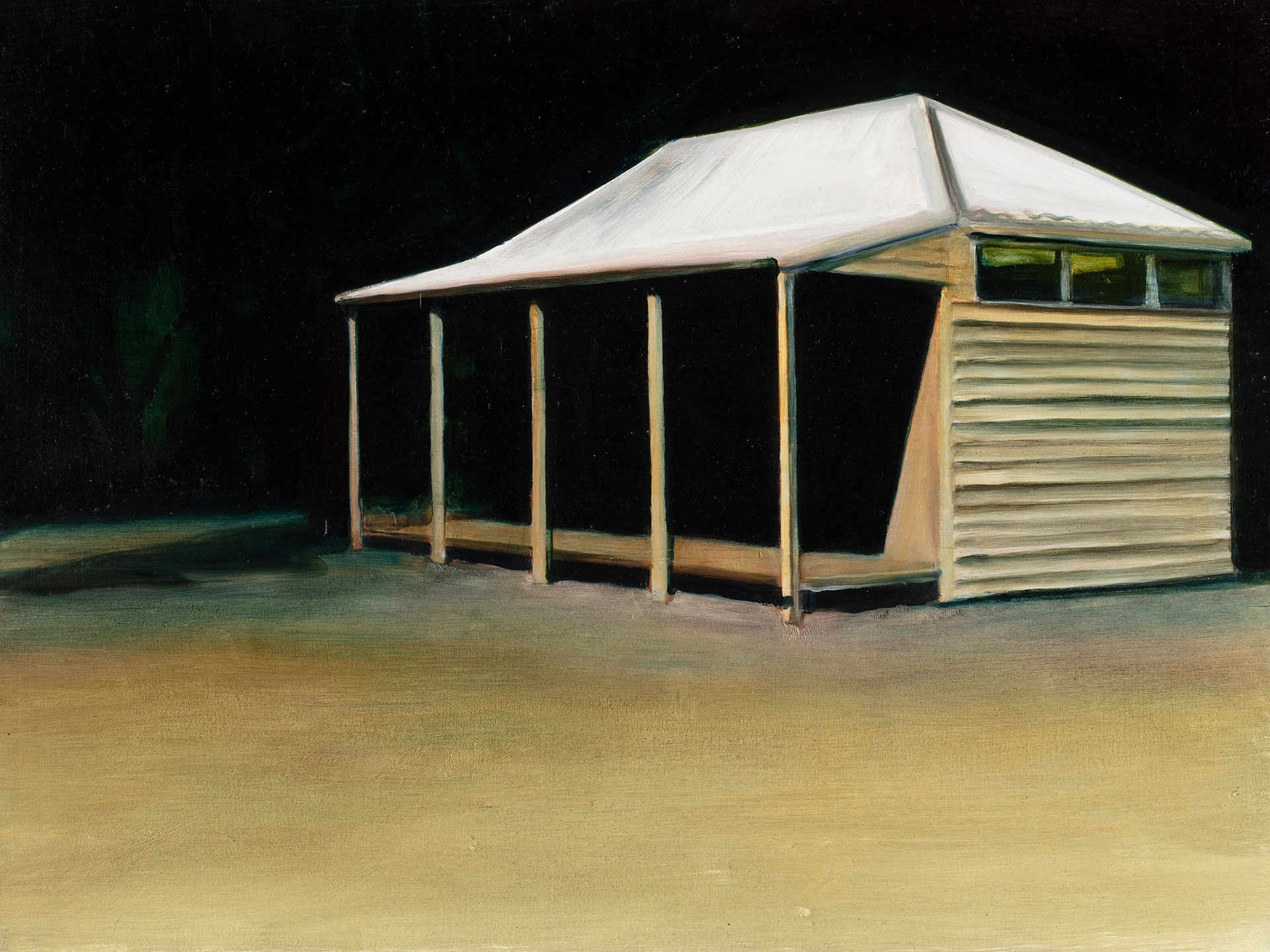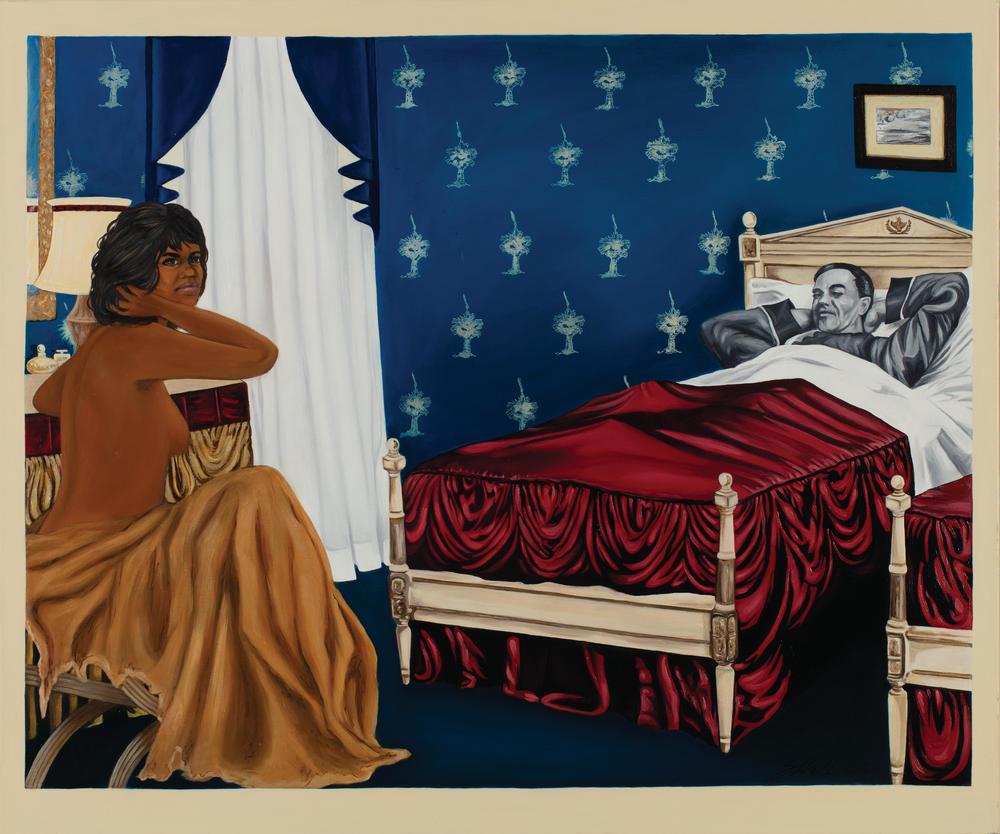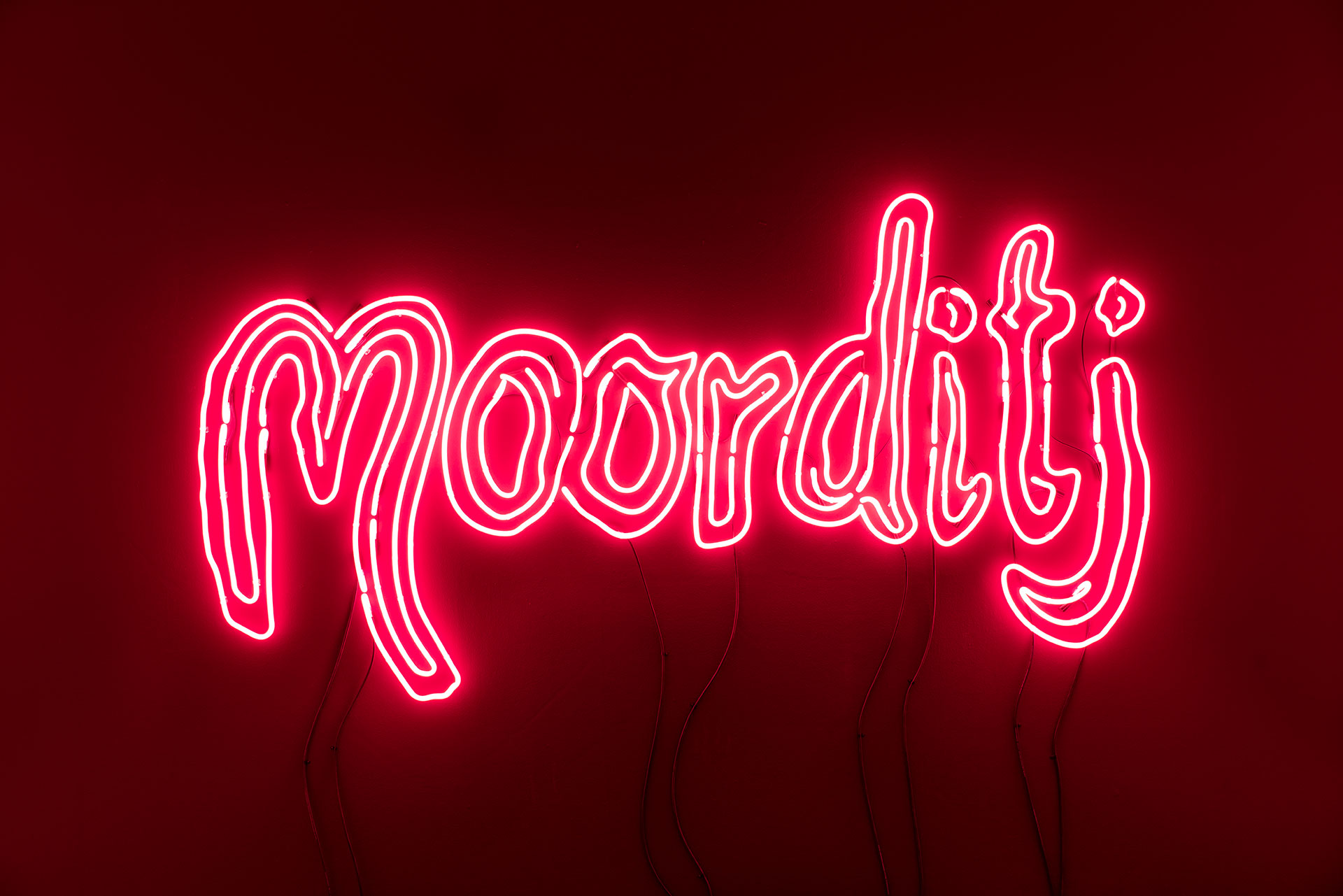Abdul-Rahman Abdullah: Throne Room
A new work by Abdul-Rahman Abdullah acts as a portable chamber of power, with a tiger skin and two monkeys hand-carved from wood referencing colonial conquest, migration and the artist’s ancestry.
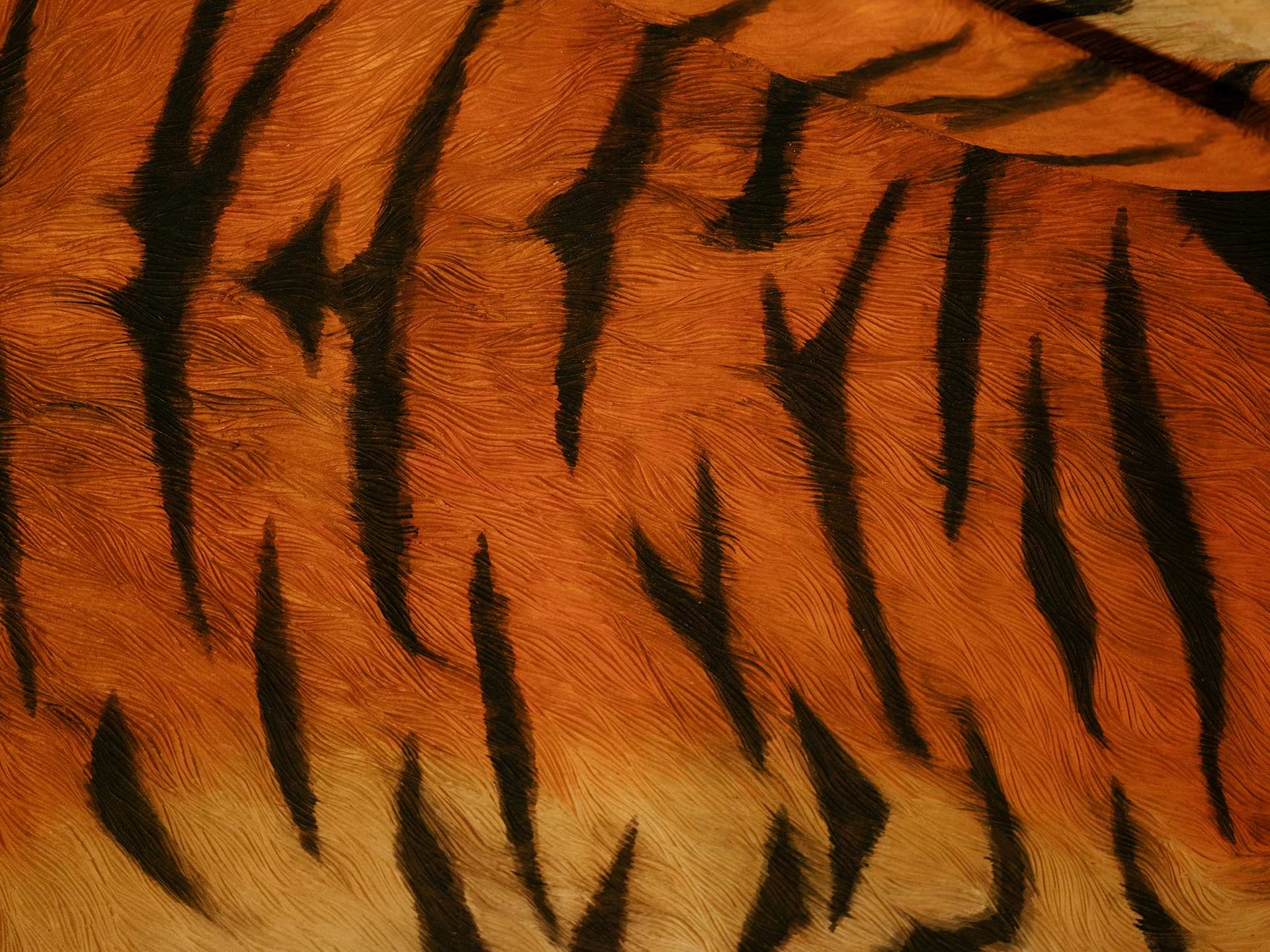
Abdul-Rahman Abdullah Throneroom 2021 (detail). Painted wood, 180 x 160 x 260 cm (overall). State Art Collection, Art Gallery of Western Australia. Purchased through the Art Gallery of Western Australia Foundation: TomorrowFund, 2021. Install image – Diaspora Pavilion 2; I am a beating heart in the world, Campbelltown Art Centre 2021. Photography by Emma Pegrum.
“IN THE SEAT of the old Luwu kingdom, Sulawesi Selatan, I found flags, weapons, baskets, ancient graves, streets full of drying cloves, a palace on stilts and an 800-year-old list of names that led from myth to me,” writes Abdul-Rahman Abdullah. This phantasmagoria of memories and experiences grounded in place, culture and history builds to a singular poetic sentiment: “I want to describe something that only exists in my mind. A throneroom.”
Abdullah was born in Port Kembla, New South Wales, in 1977. He grew up in Perth, the son of a Malay mother and an Anglo-Australian father. Since graduating from Curtin University of Technology in 2012 he has exhibited extensively, with shows at the Museum of Contemporary Art, Australian Centre for Contemporary Art, Perth Institute of Contemporary Art, and Art Gallery of South Australia. Working through the lens of his Muslim heritage, Abdullah explores lived and imagined experiences of cultural identity.
Connection to the artist’s ancestral homeland in South Sulawesi, Indonesia, is at the fore in Throneroom (2021). The work is lyrical and fanciful. It speaks of history and family, themes that ripple throughout Abdullah’s practice. The simple and beautifully executed elements of the work belie the vastness of meaning that informs their composition. Multitudes are contained within this work: wars, ships and seafarers, noble ancestors, royal scandal; the smell of cloves, island nations, colonial powers, conquerors; and a list from myth to modern day, that led Abdullah back through time, allowing glimpses of his own family story within these grand tales of human history.
Throneroom was created for 4A Centre for Contemporary Asian Art’s 2021 exhibition I am a heart beating in the world: Diaspora Pavilion 2 in Sydney. The exhibition considered the navigations, imaginings and lived experiences of artists belonging to a diaspora, who maintain connection to their ancestral homes through memories, myths and traditions. Abdullah had not thought of himself in this way until that project, though the journey to create Throneroom had begun years prior, in 2015, when he embarked on a trip through Malaysia and Indonesia to trace his family roots.
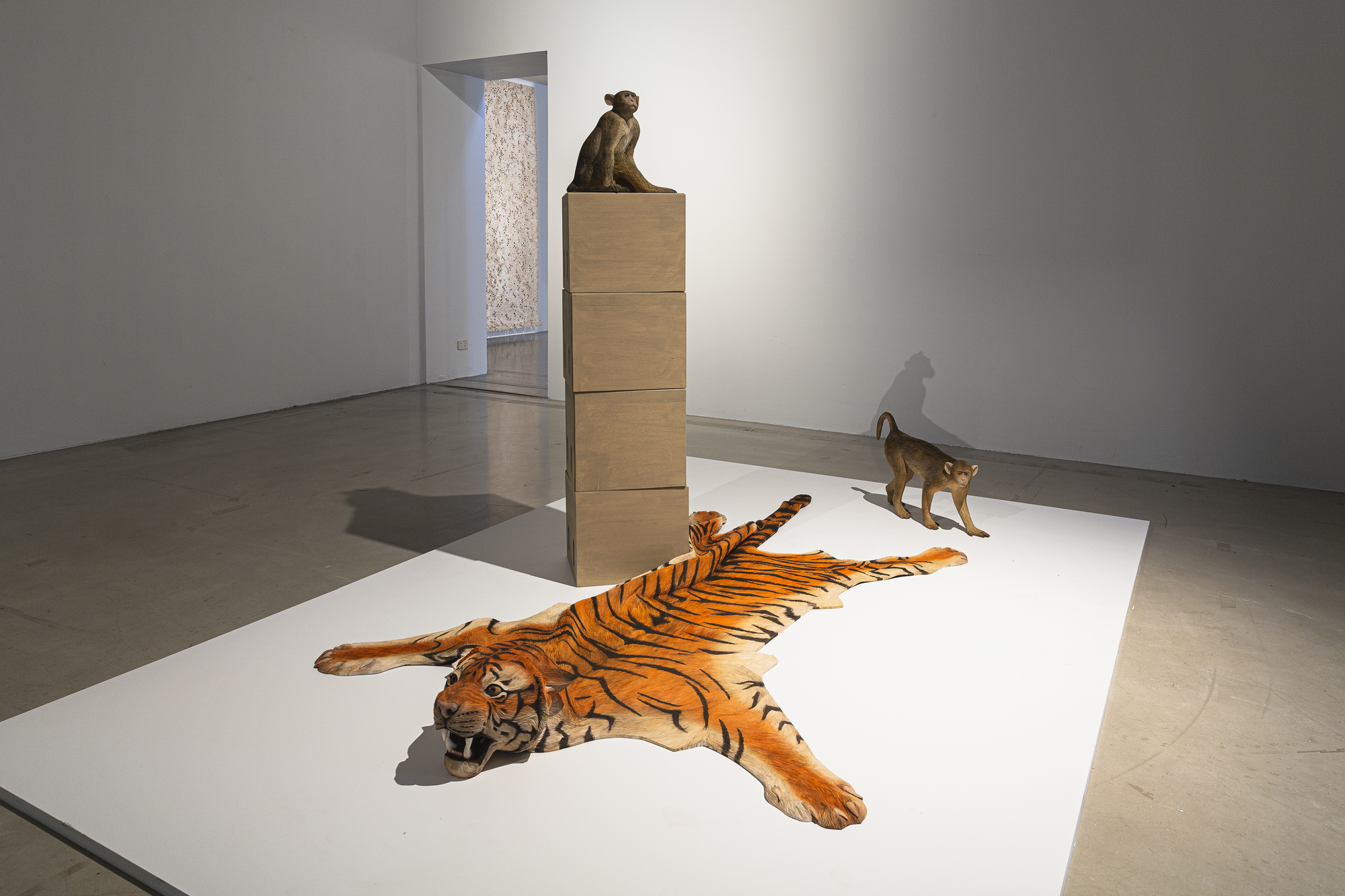
Abdul-Rahman Abdullah Throneroom 2021. Painted wood, 180 x 160 x 260 cm (overall). State Art Collection, Art Gallery of Western Australia. Purchased through the Art Gallery of Western Australia Foundation: TomorrowFund, 2021. Install image – Diaspora Pavilion 2; I am a beating heart in the world, Campbelltown Art Centre 2021. Photographer – Kai Wasikowski.
Abdullah’s mother emigrated from Malaysia to Australia in 1971. Her family line stems from old Bugis nobility originating in Sulawesi, the heart of the Spice Islands where the Dutch traversed oceans and ports from the late 1500s, seeking to dominate the lucrative global spice trade and paving the way for violent colonial conquest in the region. In 1662, Abdullah’s family was banished from the island, the result of a scandalous royal affair and a fatal duel. His ancestors left in their Perahu (an iconic Bugis ship still in use today), stopping in Borneo and Cambodia before arriving in the Malay peninsula, never to look back. Abdullah was the first person in his bloodline to return to their ancestral homeland 13 generations later.
“After that trip, I had this idea of a tiger skin sculpted in wood, something that might embody the idea of transience and freight, of movement, relating to the experiences of my family as they left Sulawesi and ended up in Malaysia,” he says. Throneroom is hand-carved, painted wood. The work depicts a full-scale tiger pelt, scrunched at its midsection by four stacked boxes. One monkey, a Macaque, sits atop the tower of boxes, while another walks at the periphery. The work is textural: the carved wood is hewn with the lines of animal fur. The features are proportionate to life and the scene is balanced: the viewer’s gaze darts between the tiger pelt, the high-seated monkey, and the ground-level monkey. The animals’ coats are luscious. The colours are vivid interpretations of life, realistic yet bright, painterly.
Like a scene from a storybook brought to life, or the set of a whimsical film, Throneroom exists as its own world within our world. Characterised by lifelike scale and his distinctive style of aestheticised realism, Abdullah’s works are model worlds, still frames from the realm of folktales, frozen in time. They are made to be experienced from all viewpoints, to draw the viewer into the scene. “I love being able to put people into the presence of something, to put them into an idea,” he says.
The Abdullah family’s rich history of travel and migration is central to the work: “The idea that this tiger skin, wherever it was, could describe a throne room, an aspirational space; you could put it down in any room and it becomes the throne room,” he says. The pelt represents a transportable power. The boxes, meanwhile, act as both a formal device providing a highpoint for the work, raising the seated monkey, and as an important thematic device, referencing trade and migration, and the movability of cultural residues.
The monkeys play an important role in the scene. They do not care about conquerors or their conquests. Like nature reclaiming an abandoned town, they audaciously reclaim the throne room. “Monkeys are such a reflection of us humans, but they are also the other, they are alien,” says Abdullah. Defiant and untameable, the monkey’s presence fills the room with life, movement, and emotion. “They are disconcerting. You cannot relax with a monkey in the room. They are everything that is human but augmented and amplified.” They remind us that we too are part of the food chain. They claim the seat of power and hence disrupt the illusion of our power as humans.
“The tiger skin, wherever it was, could describe a throne room, an aspirational space; you could put it down in any room and it becomes the throne room,” he says.
Centuries before he started exploring his family history, Abdullah’s ancestors were written into the pages of La Galigo, an epic poem spanning hundreds of years of Bugis history, originating in traditional epic-mythological creation stories and stretching to contemporary genealogical records. It is considered the longest literary work ever written in the world, and within its pages Abdullah’s own family history is transcribed. “They are noble families, and so the records and family trees were all there,” he says.
“My dad was from a convict background and my mum was from royalty,” the artist explains. “It reverses the dismissive stereotypes of Asian Australians. Mum is a migrant, a brown Muslim lady who has dealt with blatant racism on a daily basis. It was a real privilege for me to see that list of names, to know that record exists.”
As an Australian, he says, it’s hard to escape a romanticised view of south-east Asia. “I realised how colonial that view was, the lens I was seeing my heritage through. The limitations of my perspective became really obvious to me. Class systems became apparent, and how I was the beneficiary of that. When you encounter your own privileges, the least you can do is recognise them.”
The air still smells of clove in Sulawesi. Hundreds of years on, the spice trade continues. The Bugis traders, seafarers and navigators whose histories are based on wars, upheaval and migration still thrive throughout south-east Asia. Today, diaspora can be coloured by a sense of nostalgia, a longing to reconnect with distant homelands through memory, myth or tradition. Only by looking back, and retracing the chronicles of peoples, cultures and empires, is it possible to look ahead. “I think of these things as cultural objects that describe a time and a place, from another time and another place,” Abdullah muses of Throneroom. “And if it does that for me, then it should be here, and it should exist.”
This article was first published in the print publication The View From Here in October 2021 under the title Abdul-Rahman Abdullah: Throne Room.
